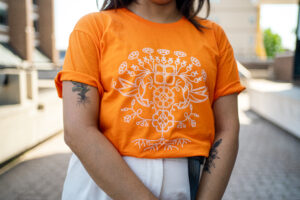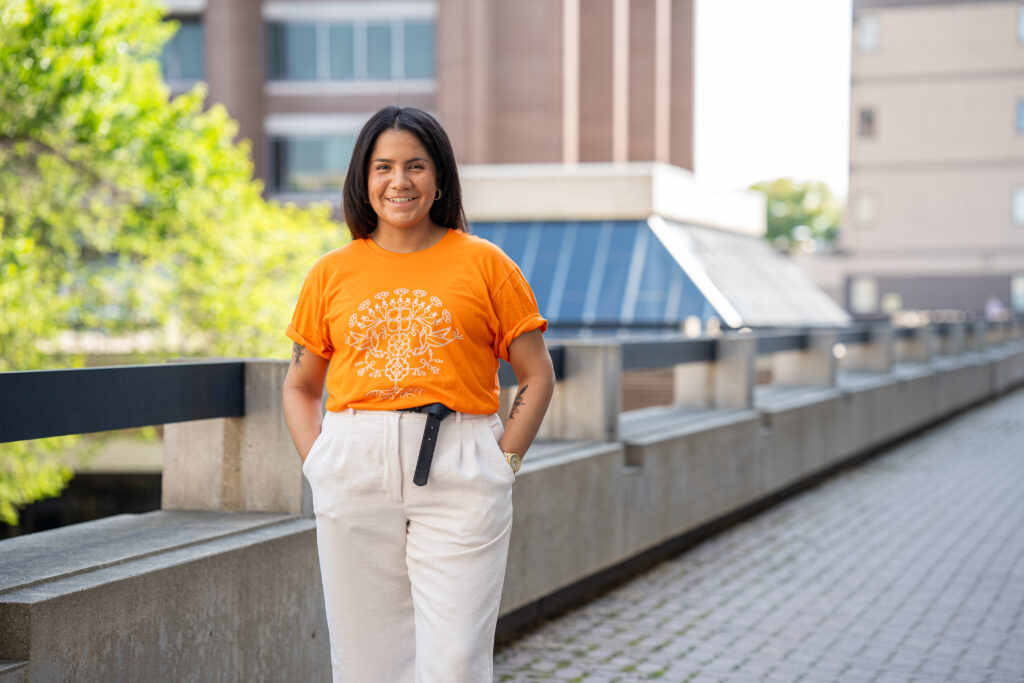Grad unveils new Orange Shirt Day design to inspire hope and strength
The art of RRC Polytech grad Leticia Spence is featured in media across Canada and the globe; closer to home, you’ve likely seen it worn proudly by fans and players at Winnipeg Jets and Manitoba Moose games.
For her latest work, Spence — a Graphic Design grad from 2019 — partnered with the College to create this year’s Orange Shirt Day illustration in support of Truth and Reconciliation and the Every Child Matters movement.
Spence’s concept for the shirt came through collaboration with Indigenous staff members at the College, who felt her design provided a beautiful and harmonious representation of all Indigenous Nations.
She grounded the design in Cree floral beadwork and integrated symbols from the Inuit and Métis Nations: fireweed flowers, wild roses, rosebuds and berries. The focus on nature represents the Peoples’ roots in the land, Spence says, while the foundational beadwork carries energy and transfers the art’s intention spiritually.
“I want whoever is wearing this t-shirt to feel a sense of hope and strength as they honour those who are currently being found while knowing that it’s okay to create space to honour themselves as either direct residential school survivors or intergenerational residential school survivors,” says Spence in an artist’s statement that will accompany each shirt sold.
“In difficult times, hope is the one thing we can grasp onto — not only to survive, but to drive us to fight for a world in which we no longer have to cry out for justice, and to reinforce that we deserve to exist.”
Spence credits her mom with recognizing her talents and encouraging her to pursue art from an early age. To nurture her creativity, her mom would occasionally buy her pencils, paints and sketchbooks — items Spence says she treasured due to the unpredictability of their circumstances.
Between living on reserve and in downtown Winnipeg, Spence found stability hard to come by in many aspects of her childhood. Her anxiety, compounded by her environment, inclined her to withdraw, especially in high school. Sometimes she’d go days without speaking to another student.
Spence was a shy kid and says that art was her rock — the thing that anchored her and helped her to get out of her head. It was an escape as much as it was a home — how she expressed herself when she couldn’t find the words. She recalls often staying up until 3:00am drawing to forget about the things happening around her.
In her last year of high school, Spence began considering a career in the arts, inspired by a brochure commission from the Rainbow Resource Centre, the first time she’d been paid for her art. She was later invited to the organization’s graphic design studio, where she witnessed the behind-the-scenes creation of art for commercial use.
At the time, though, Spence was too busy with schoolwork, and later — despite prompting from a teacher who encouraged her to consider college courses to develop her skills — opted instead for university. Three years of school (and one language exchange program in Japan) later, she found she was spending too much time on theory, writing and waiting, and not enough time creating.
She revisited her teacher’s recommendation and applied to RRC Polytech in 2017.
“My career is truly like capturing a flash in a bottle,” says Spence. “I didn’t anticipate much, but all the opportunities I’ve taken, they’re more than what I thought I could achieve. Growing up in Winnipeg and experiencing racism and poverty can make it hard to see your value at first.”
Of the many projects Spence participated in throughout her career, she says her proudest accomplishments are those where she could authentically express her identity as an Ininew person.
In 2022, Spence collaborated with Inuit artist Jason Sikoak and Métis artist JD Hawk on the Truth and Reconciliation Keepsake for the Royal Canadian Mint and the National Centre for Truth and Reconciliation. She says it was the first project she put into the universe that wholly represented her identity, and that gave her the space to demonstrate her Cree values and knowledge without restraint.
 This year’s Orange Shirt Day collaboration with RRC Polytech is one of the first projects she’s worked on since taking time off after experiencing burnout. Focusing too much on keeping up with production left her emotionally and financially drained.
This year’s Orange Shirt Day collaboration with RRC Polytech is one of the first projects she’s worked on since taking time off after experiencing burnout. Focusing too much on keeping up with production left her emotionally and financially drained.
“My work comes from a spiritual place, but if I can’t nurture that because of all this other stuff going on — you know, making deadlines, meeting expectations, paying bills — it really impacts the quality,” she says. “I took a break this spring for some much-needed rest, then when RRC Polytech came knocking with this design proposal, it was a really exciting and welcome opportunity.”
Spence’s shirts — which commemorate both Truth and Reconciliation Week and Orange Shirt Day: Every Child Matters (on Sept. 30) — mark the last project she’ll complete in Manitoba before making an exciting move to Quebec, where she looks forward to new career opportunities, reconnecting with family, and exploring the province’s diverse music scene.
Produced by Red Rebel Armour, an Indigenous streetwear outlet owned and operated by RRC Polytech grad Sean Rayland-Boubar, the shirts can be purchased through the College’s Campus Stores.
All proceeds go to the College’s Mínwastánikéwin Truth and Reconciliation Award, which aims to alleviate financial burden for Indigenous students. Last year, two students received the award thanks to support from the College community and the RRC Polytech Students’ Association.
Artist’s Statement
 As an Ininew person, I wanted to create something utilizing Cree florals because beadwork is something that I grew up watching my family members do. Beadwork carries energy. I’ve been taught to put good intentions into my beads and that’s what I wanted to achieve through this t-shirt design.
As an Ininew person, I wanted to create something utilizing Cree florals because beadwork is something that I grew up watching my family members do. Beadwork carries energy. I’ve been taught to put good intentions into my beads and that’s what I wanted to achieve through this t-shirt design.
I want whoever is wearing this t-shirt to feel a sense of hope and strength as they honour those who are currently being found, while knowing that it’s okay to create space to honour themselves as Residential School Survivors or Intergenerational Residential School Survivors.
In difficult times, hope is the one thing we can grasp onto — not only to survive, but to drive us to fight for a world in which we no longer have to cry out for justice, and to reinforce that we deserve to exist.
I wanted to create a tree with florals because of the medicine and protection they gift us, to represent our connection to this land and how we’re rooted here.
On the outer perimeter of the tree, sunflowers with seven petals represent the seven Grandfather Teachings and thirteen strawberries for the thirteen moon cycles.
Starting from the top, just below the strawberries, is a fireweed flower for the Inuit Nation.
The floral with the four cardinal directions in the middle represents First Nations.
The wild rose with two rosebuds creating the infinity symbol represents the Métis Nation.
Flanking the tree on each side are two hummingbirds feeding from the nectar of the flowers in the middle. I chose hummingbirds for their ability to see things from multiple perspectives. The hummingbirds, along with the vines branching out from the trunk of the tree, build out two faces to represent our ancestors that walk with us on our journeys.
I chose to branch out rosehips, rosebuds and berries from the bottom of the tree because they’re common motifs in Cree beadwork.

